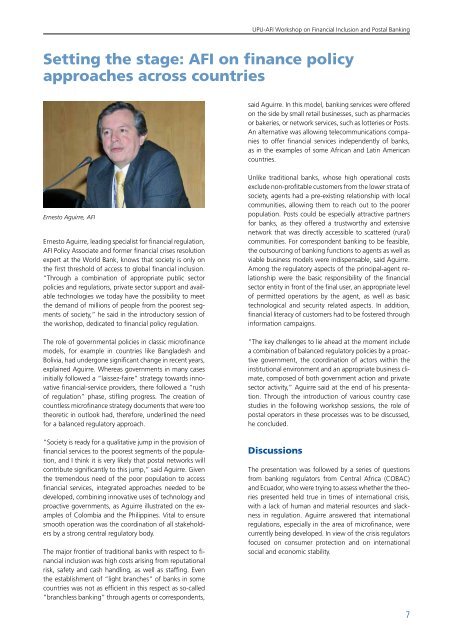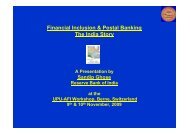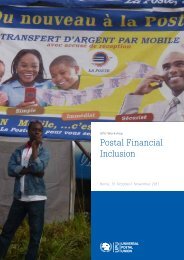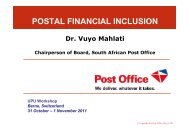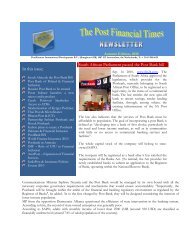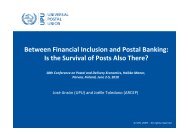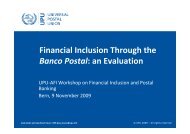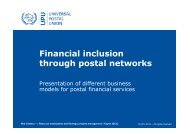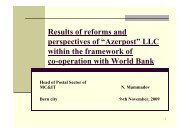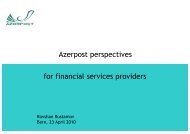Financial Inclusion and Postal Banking - Postal Financial Inclusion
Financial Inclusion and Postal Banking - Postal Financial Inclusion
Financial Inclusion and Postal Banking - Postal Financial Inclusion
You also want an ePaper? Increase the reach of your titles
YUMPU automatically turns print PDFs into web optimized ePapers that Google loves.
UPU-AFI Workshop on <strong>Financial</strong> <strong>Inclusion</strong> <strong>and</strong> <strong>Postal</strong> <strong>Banking</strong><br />
Setting the stage: AFI on finance policy<br />
approaches across countries<br />
said Aguirre. In this model, banking services were offered<br />
on the side by small retail businesses, such as pharmacies<br />
or bakeries, or network services, such as lotteries or Posts.<br />
An alternative was allowing telecommunications companies<br />
to offer financial services independently of banks,<br />
as in the examples of some African <strong>and</strong> Latin American<br />
countries.<br />
Ernesto Aguirre, AFI<br />
Ernesto Aguirre, leading specialist for financial regulation,<br />
AFI Policy Associate <strong>and</strong> former financial crises resolution<br />
expert at the World Bank, knows that society is only on<br />
the first threshold of access to global financial inclusion.<br />
“Through a combination of appropriate public sector<br />
policies <strong>and</strong> regulations, private sector support <strong>and</strong> available<br />
technologies we today have the possibility to meet<br />
the dem<strong>and</strong> of millions of people from the poorest segments<br />
of society,” he said in the introductory session of<br />
the workshop, dedicated to financial policy regulation.<br />
The role of governmental policies in classic microfinance<br />
models, for example in countries like Bangladesh <strong>and</strong><br />
Bolivia, had undergone significant change in recent years,<br />
explained Aguirre. Whereas governments in many cases<br />
initially followed a “laissez-faire” strategy towards innovative<br />
financial-service providers, there followed a “rush<br />
of regulation” phase, stifling progress. The creation of<br />
countless microfinance strategy documents that were too<br />
theoretic in outlook had, therefore, underlined the need<br />
for a balanced regulatory approach.<br />
“Society is ready for a qualitative jump in the provision of<br />
financial services to the poorest segments of the population,<br />
<strong>and</strong> I think it is very likely that postal networks will<br />
contribute significantly to this jump,” said Aguirre. Given<br />
the tremendous need of the poor population to access<br />
financial services, integrated approaches needed to be<br />
developed, combining innovative uses of technology <strong>and</strong><br />
proactive governments, as Aguirre illustrated on the examples<br />
of Colombia <strong>and</strong> the Philippines. Vital to ensure<br />
smooth operation was the coordination of all stakeholders<br />
by a strong central regulatory body.<br />
The major frontier of traditional banks with respect to financial<br />
inclusion was high costs arising from reputational<br />
risk, safety <strong>and</strong> cash h<strong>and</strong>ling, as well as staffing. Even<br />
the establishment of “light branches” of banks in some<br />
countries was not as efficient in this respect as so-called<br />
“branchless banking” through agents or correspondents,<br />
Unlike traditional banks, whose high operational costs<br />
exclude non-profitable customers from the lower strata of<br />
society, agents had a pre-existing relationship with local<br />
communities, allowing them to reach out to the poorer<br />
population. Posts could be especially attractive partners<br />
for banks, as they offered a trustworthy <strong>and</strong> extensive<br />
network that was directly accessible to scattered (rural)<br />
communities. For correspondent banking to be feasible,<br />
the outsourcing of banking functions to agents as well as<br />
viable business models were indispensable, said Aguirre.<br />
Among the regulatory aspects of the principal-agent relationship<br />
were the basic responsibility of the financial<br />
sector entity in front of the final user, an appropriate level<br />
of permitted operations by the agent, as well as basic<br />
technological <strong>and</strong> security related aspects. In addition,<br />
financial literacy of customers had to be fostered through<br />
information campaigns.<br />
“The key challenges to lie ahead at the moment include<br />
a combination of balanced regulatory policies by a proactive<br />
government, the coordination of actors within the<br />
institutional environment <strong>and</strong> an appropriate business climate,<br />
composed of both government action <strong>and</strong> private<br />
sector activity,” Aguirre said at the end of his presentation.<br />
Through the introduction of various country case<br />
studies in the following workshop sessions, the role of<br />
postal operators in these processes was to be discussed,<br />
he concluded.<br />
Discussions<br />
The presentation was followed by a series of questions<br />
from banking regulators from Central Africa (COBAC)<br />
<strong>and</strong> Ecuador, who were trying to assess whether the theories<br />
presented held true in times of international crisis,<br />
with a lack of human <strong>and</strong> material resources <strong>and</strong> slackness<br />
in regulation. Aguirre answered that international<br />
regulations, especially in the area of microfinance, were<br />
currently being developed. In view of the crisis regulators<br />
focused on consumer protection <strong>and</strong> on international<br />
social <strong>and</strong> economic stability.<br />
7


